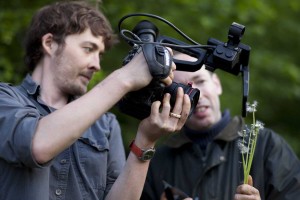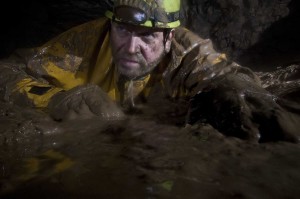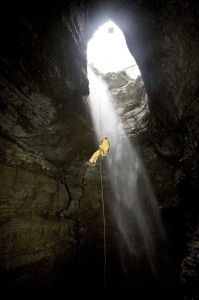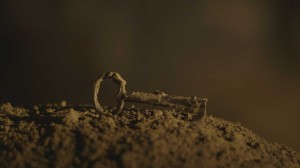
As second unit director and one of several cinematographers on Tobias’ film No Place on Earth, Nicholson’s assignment was to re-create scenes showing how 38 Ukrainian Jews hid from the Nazis for 18 months in what today is recognized as the longest underground survival in recorded human history. No Place on Earth took two years to produce and combines re-enactments and interviews with four elderly survivors to tell a remarkable story of courage and endurance.
“I would take one of the actors deep into the cave and go through crevasses that you couldn’t even get lighting equipment into,” Nicholson explained. “These are places that are physically challenging even without a camera. There are ultra-compact cameras available, but I used the Canon EOS C300 because these images had to look great on big screens in movie theaters. I use only candles for lighting many of those scenes because that’s what they had in the caves during the war. Those candle-lit EOS C300 camera shots are in the film and they look beautiful, and it was only the compact size and low-light capabilities of the EOS C300 camera that made them possible.”
“The Canon EOS C300 camera enabled Zac to maneuver in the caves as a very mobile second unit,” explained Tobias. “There are a number of quite intimate images that I think are very important for conveying the emotional message of the film that were captured with the EOS C300 camera. These included images of children. The simple setups made possible by the compact EOS C300 camera enabled the children to be very natural in re-creating the experience of everything from play to fear inside the cave. We were also able to capture scenes of climbing and digging in very tight spaces, high up inside a shaft that would have involved unbelievably expensive and complex rigging had we used a larger camera. The Canon EOS C300 camera is an incredibly nimble camera with a beautiful image and it was invaluable to us on both budgetary and artistic levels.”

“I love the challenge of boundaries and obstacles in filmmaking,” Nicholson added. “We were dealing with a harsh environment that didn’t really ‘want’ us to be filming in it, and we used illumination that wasn’t made for motion capture, yet the EOS C300 camera delivered great results. The candles and oil lanterns we used for certain scenes also served as ‘practicals’ that could be photographed for realism. Plus, I was directing actors that didn’t speak English, so giving them a prop such as a candle and allowing them to explore with it, and then being able to capture those images made for great footage.”
Multiple cinematographers working with separate teams in Hungary, Slovakia and the Ukraine used a variety of professional digital movie cameras to shoot No Place on Earth. Nicholson had originally been asked by Tobias to shoot behind-the-scenes content with a Canon EOS 5D Mark II digital SLR camera. Some of that footage later became integral to the film’s climax. Then when the Canon EOS C300 became available Nicholson purchased that camera, and it became the camera of choice for capturing even more key scenes.
“I had been using the Canon EOS 5D Mark II for a lot of my own documentaries and narrative experimental work,” Nicholson said. “I think Canon was the first to understand what they had created for filmmakers in the DSLR market, and then to push that beyond its boundaries into new areas. For a long time I had been waiting for something I would be comfortable shooting movies with that didn’t use film. The EOS C300 camera was what I had been waiting for. I have heard other filmmakers praise the EOS C300 camera, and everything I saw from it was extraordinary. Plus, I’d be able to use my Canon EF lenses with the EOS C300 camera.
“There were a lot of things that we did with the EOS C300 camera for No Place on Earth that were in environments that were so difficult to shoot in that we could not have physically or logistically done them with a larger digital cinematography camera, especially one requiring assistants. The EOS C300 camera provides a small, almost DSLR-like shape and structure, which is highly portable and maneuverable, and yet it gives you a sensor that can match those of the larger digital cinema cameras.”

“We had two actors dressed as SS soldiers and a limited period of perfect ‘magic hour’ light to capture a whole sequence of shots of them looking into hiding places,” Nicholson recounted. “We needed a variety of shots to tell the story, and we were really only able to get them all done because of the size of the EOS C300 camera, which gave us the ability to move and shoot on the fly. If we saw something interesting happening in real time in front of us with the actors, I could just pop the camera off the tripod and start shooting.”
The detachable top handle on the Canon EOS C300 digital cinema camera includes a 1.55 megapixel adjustable-angle 4-inch color LCD monitor for accurate judgment of composition, focus and color. A bright 1.55 megapixel electronic viewfinder (EVF) is built into the camera body. Both the EVF and the LCD monitor can display a waveform monitor, vectorscope and other screens for adjusting picture quality.
“In general, I used a mixture of the EVF and LCD,” said Nicholson. “If the EOS C300 camera was on a tripod for a set shot, I preferred to use the flip-out LCD screen. For hand-held work I used the eyepiece because it felt more natural, like a 16mm camera. Also, it gave me an extra layer of stability. I used the battery that comes with the EOS C300 camera and a slightly larger external battery, and between those two I always had more than enough power, even with the LCD out and the camera on and running for extended periods. I never even came close to running out of batteries.”
The C300 records to two CF (Compact Flash) cards through dual slots with a choice of serial or parallel (for backup) recording, providing up to 80 minutes of recording time on each 32GB card. “I own four CF cards, and used them instead of an external recorder or computer, which you don’t want to be hooked up to when you’re down in a cave,” Nicholson explained. “Our DIT periodically downloaded the CF cards and had them back to me in 15 minutes, so I never had to worry about not having enough card space.”
Nicholson used the EF-mount version of the EOS C300 Cinema camera to shoot his portions of No Place on Earth.

Postproduction Workflow
Editing and other postproduction work for No Place on Earth had to include footage shot in multiple digital cinematography formats. The Canon EOS C300 workflow relied on the industry-standard MXF (Material eXchange Format) container file format for compatibility with the editing systems. In addition, the EOS C300 can record in Canon Log mode, which captures a full 12 T-stops of exposure latitude.
“I shot all Canon Log,” Nicholson noted. “The latitude of the EOS C300 camera is fantastic and gave us so much creativity in both production and post. Integrating multiple digital cinema formats required the broad latitude in the stop range and the EOS C300 camera delivered that. Having shot so much on the fly with quick lighting set-ups, the ability to capture so much detail with images that we could play with later in post was a great comfort factor.”
No Place on Earth premiered at the 2012 Toronto International Film Festival. It is currently being shown in theaters by Magnolia Pictures in the U.S.
“This is a story with incredible meaning,” said Tobias. “At the end of the day you carry away that it’s not just a great adventure/survival story, you carry away what people are capable of doing under impossible-to-imagine circumstances.”





